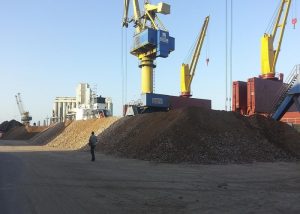Oil additives and fluid loss control additive are chemical substances added to oils and industrial fluids such as natural bitumen to impart or improve certain properties. They are used with lubricants, coolants, thermal oils, greases, and metalworking fluids.
Moreover, drilling fluid loss control additive are water-based drilling mud most commonly consists of bentonite clay (gel) with additives such as barium sulfate (barite), calcium carbonate (chalk) or hematite. In the meantime, what is fluid loss in drilling is the leakage of the liquid phase of drilling fluid, slurry or treatment fluid containing solid particles into the formation matrix.

What is Fluid Loss Control Additive?
At first we want to answer the question: what is fluid loss? Fluid loss control additive is also called filtration control agents. Fluid loss control additives may occur when the fluid such as natural bitumen comes in contact with a porous formation. This is relevant for drilling and completion fluids, fracturing fluids, and cement slurries.
fluid loss control additives may occur when the fluid comes in contact with a porous formation.
Thus, fluid loss additives drilling mud are used in a variety of fluids incl. Gilsonite is used for different purposes. Because the fluids used in petroleum technology are in some cases quite expensive, an extensive fluid loss may not be tolerable. Of course there are also environmental reasons to prevent fluid loss control additives. Reduced fluid loss can be achieved by plugging a porous rock in some way.
In the meantime, if you intend to get acquainted with bitumen, stay tuned for this article.
What is Fluid Loss in Drilling Mud?
The leakage of the liquid phase of drilling fluid loss control additive, slurry or treatment fluid containing solid particles into the formation matrix is called drilling mud fluid loss. The resulting buildup of solid materials or filter cake may be undesirable, as may the penetration of filtrate through the formation.
Drilling fluid loss control additive systems are designed and formulated to perform efficiently under expected wellbore conditions. Fluid loss additive is used to control the process and avoid potential reservoir damages. A group of specially designed fluid loss-containing additives is used to lower filtration volume.
Meanwhile, these well-known materials are available for all types of water and oil-based mud; as well as by static filtration tests, they are fully evaluated.
Fluid Loss Additive Drilling Mud
In the beginning, we should define an important question: what is fluid loss?
A standard plate and frame filter press test the fluid loss control additive, which this method of separating a mixture of liquid and insoluble solids is called dewatering.
It is beneficial to explain properties of drilling fluids and mud cakes. Meanwhile, advances in drilling fluid technologies have made it possible to implement a cost-effective, fit for purpose system for each interval in the well-constructed process.
The drilling fluid loss control additives‘ functions are designed for cleaning the borehole, balance as well as overcome formation pressure, supports and stabilizing the wellbore’s walls, up to casing can be set, lubricate drilling bit, suspending drill cuttings, as well as carry the details of wellbore into the surface. The mud viscosity is another important property, as cuttings will settle to the bottom of the well if the density is too low.
Various types of drilling fluid’s properties are adjusted and monitored for achieving the desired performances. In the meantime, the multiple tests’ interpretation as well as resulting the treatments, maintaining appropriate fluid properties to the drilling program’s success.

Fluid Loss Additives Examples
In fluid loss additives drilling mud examples like the filter cake becomes thicker, the filter resistance increases as well. So when the separating chamber is full, the filtration process is stopped as the optimum pressure difference is reached. The filtrate that passes through filter cloth is collected through collection pipes and stored in the filter tank.
Filter cake (suspended solid) accumulation occurs at the hollow plate frame, then being separated at the filter plates by pulling the plate and frame filter press apart. The cakes then fall off from those plates and are discharged to the final collection point. Cake discharge can be done in many ways.
If you want to get acquainted with asphalt, its features and the three most widely used types of asphalt in the world, read the natural asphalt article from the blog of Nikan West Gilsonite Company.
For example: Shaking the plates while they are being opened or shaking the clothes. A scraper can also be used, by moving from one chamber to another and scraping the cake off the cloth. At the end of each run (fluid loss control additive), the clothes are cleaned using wash liquid and are ready to start the next cycle. We want to explain to you some fluid loss additives examples as follows:
- CMC (Carboxymethyl Cellulose)
- STARCH
- SODA ASH (Sodium Carbonate)
- CAUSTIC SODA (Sodium Hydroxide)
- Wood Fibers
Those were the fluid loss additives examples. If you want to know more about the Fluid loss control additive follow Nikan west gilsonite company “the Gilsonite producer “ on Instagram.
Difference Between Drilling Fluid and Drilling Mud
Liquid and mud used to drill boreholes, but the composition of them is very different. One term is often used for the other, but strictly speaking, a gaseous drilling fluid loss control additive is a fluid using an array of gases. But fluids that are water or oil-based are called mud.
A wide range of materials and parts are needed to get the fluid loss control additives into the borehole. For example, like those made by PVC Plus, geothermal supplies are commonly found on drilling sites.
These include geothermal pipes, which may be made of plastic, metal and coil tubing as well as cable. Furthermore, geothermal fittings also are essential for flanges, joint adapters, and couplings which are similar to geothermal pipes.
A good screen is an essential part of the drilling process because it allows access to a more extensive surface area, letting water seep into the healthy stem from surrounding sand and soil.
Many drilling areas have heavy oil, meaning the oil being drilled contains a lot of sand and sediment. In these locations, slotted pipes are essential to filter out the sand during the borehole pumping.
Each of the components plays an essential part in the drilling process. In case of breaking an item, while a new one is located and installed, the whole drilling site may be shut down. That is why one of the most critical jobs on any drilling site is monitoring well supplies. Enough items of each part need to be kept on hand since most drilling spots are far from regular distribution points. Well-drilling stores often need to be flown into remote locations .
What is a Filtration Control Agent?
Fluid loss control agents also addressed as filtration control additives or fluid loss control additives are used in healthy cement compositions to reduce the fluid loss additives from the cement compositions to permeable formations or zones through the cement compositions are pumped.
In primary cementing, failure of liquid (in this case is water) to porous subterranean formations or zones can result in premature gelation of the cement composition whereby bridging of the annular space between the permeable formation or zone, the pipe string cemented thereon which this is prevents the cement composition from placed over the whole length of the annulus.
Filtration control additives or fluid loss control additives are added to types of cement for the same reason as they are used in drilling fluids. However, untreated cement slurries have much greater filtration rates than do untreated drilling muds. Therefore it is essential to limit water loss from a slurry into a permeable formation.
However, the mechanism of action of filtration control additives or fluid loss control additives is not yet completely understood. Examples are bentonite, latex, and various organic polymers. Many additives for fluid loss are water-soluble polymers.
Moreover, all you need to know about Natural Bitumen follow us in the next articles.


